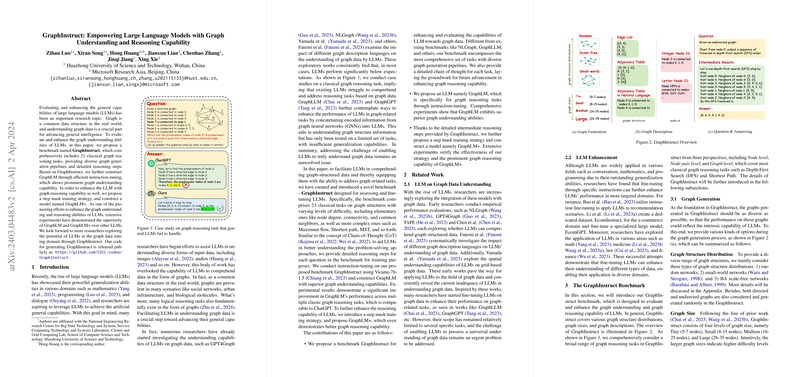The paper "GraphInstruct: Empowering LLMs with Graph Understanding and Reasoning Capability" introduces a novel approach to enhance the graph understanding and reasoning capabilities of LLMs. Recognizing the limitations of current LLMs in handling graph-structured data, the authors present a benchmark named GraphInstruct. This benchmark is meticulously designed to include 21 classical graph reasoning tasks, such as node degree, connectivity, shortest path, and maximum flow, among others.
The primary contributions of this paper are organized as follows:
- GraphInstruct Benchmark:
- The benchmark encompasses a comprehensive set of tasks covering node-level, node-pair-level, and graph-level reasoning challenges.
- Each task is associated with detailed problem-solving steps, akin to the Chain-of-Thought method, aimed at enhancing the LLMs' problem-solving capabilities.
- The diversity of graph structures in the benchmark is achieved through various graph generation methods like random networks, small-world networks, and BA scale-free networks. Graphs are objectified by different description languages and node ID representations to test model versatility.
- GraphLM and GraphLM+ Models:
- GraphLM is developed through instruction-tuning on GraphInstruct using a fine-tuning strategy with LoRA, enhancing the graph understanding capability of the base model Vicuna-7b.
- GraphLM+ further builds on GraphLM by incorporating intermediate reasoning steps as supervision signals. A step mask training strategy filters redundant information to focus on relevant graph structure information, thereby bolstering graph reasoning capabilities.
- Experimental Evaluation:
- GraphLM notably outperforms other LLMs like Vicuna-7b and exhibits performance comparable to GPT-3.5-turbo across various graph reasoning tasks.
- Despite advancements, both GraphLM and GPT4 show weaknesses in complex graph reasoning tasks, manifesting the existing difficulty in LLMs' comprehension of such data.
- The paper details extensive experiments demonstrating GraphLM+'s superior ability to handle tasks using the one-shot Chain-of-Thought technique, reflecting significantly improved reasoning capabilities.
- The generalization of GraphLM's performance was assessed in diverse settings involving different graph sizes, description languages, and node ID representations, where it consistently maintained a performance edge.
In conclusion, the paper advances the understanding of LLMs in graph domains by systematically exploring the graph-structured data comprehension challenges, providing a robust benchmark, and detailing novel model architectures. It opens pathways for further exploration into the interplay between LLMs and graph data mining tasks, aiming to bridge the gap in LLM capabilities regarding graph reasoning. Future directions include expanding the diversity of GraphInstruct tasks to real-world applications and further enhancing LLM integration with graphs.
